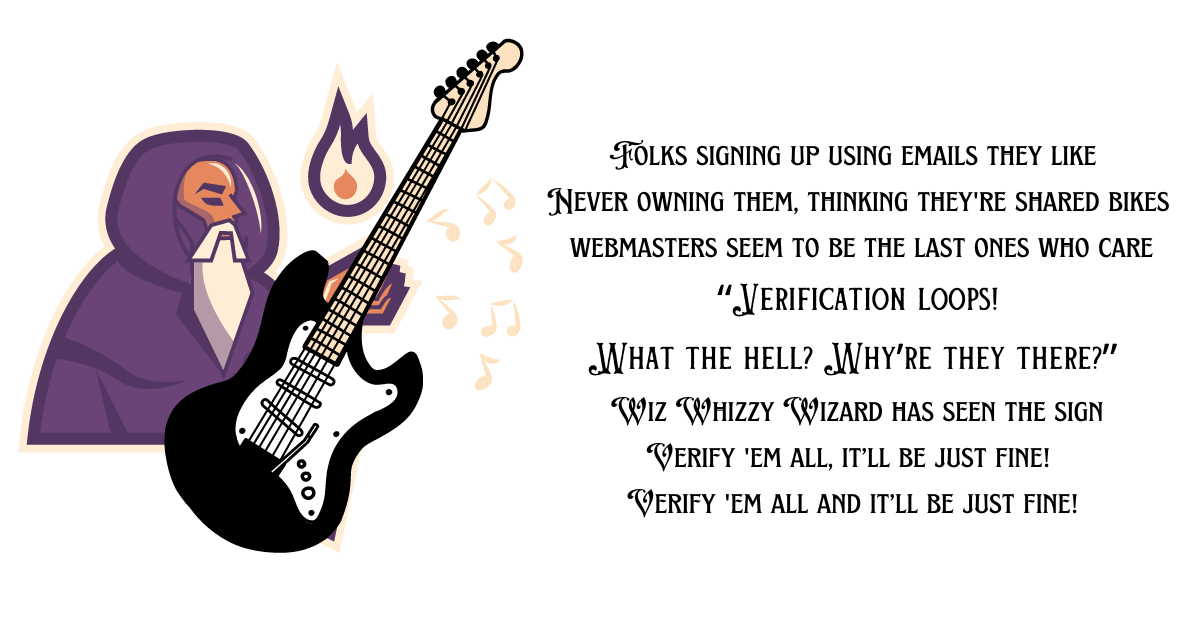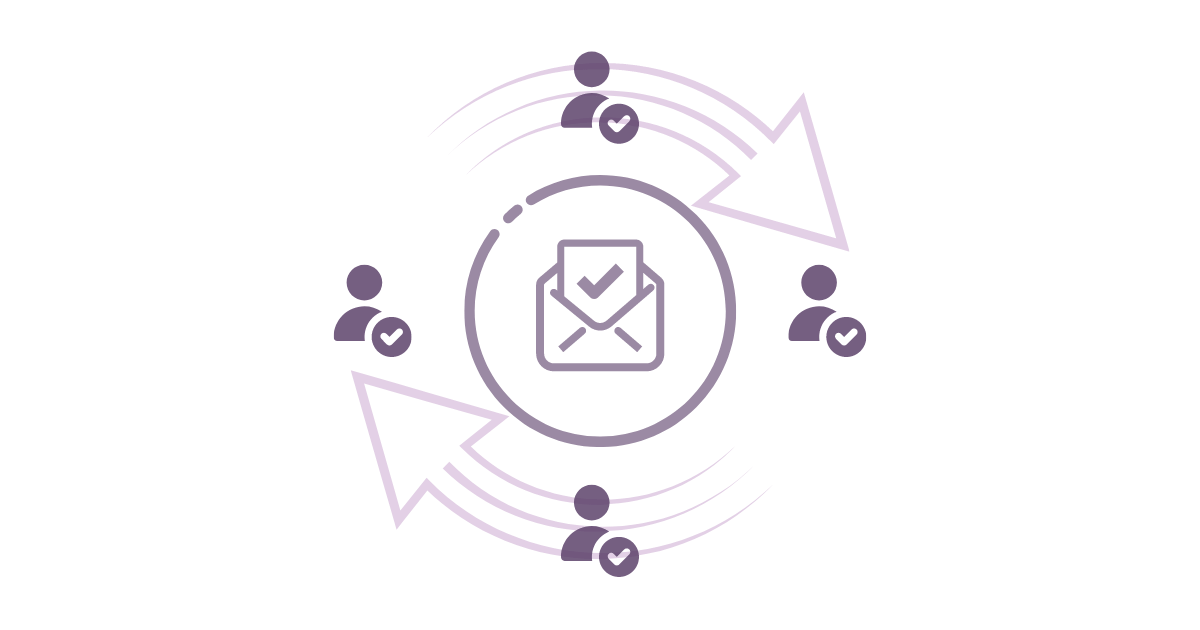I have gone live with my first SEORock song. And, of course it has to start with keywords

Are You Really Verifying Your Email Subscribers Correctly?
But first a little story!
( Click here if you want to quickly jump to the how-to steps)
There once was a king who had the best email id in the world but he was not happy. He was getting tons of welcome emails from websites that he never even visited—let alone sign up for.

He had no idea how to tackle this menace so he sent for the wise wizard from the mountains. The wiz, always eager to rock his wisdom, was there in a jiffy. He picked up his guitar (they never had those in the days of old but the wizard was a wiz, you know, and could summon anything from the future). And thus he sang:

The king was excited that at last, he understood the root of the problem and was now empowered to do something about it. Armed with the knowledge of the wizard’s deep wisdom, the king decided to put his foot down and take down all websites that do not have an email “verification loop”. Following the announcement of his decision, there was mayhem and everyone scrambled to implement the all-important verification loop as prescribed by the oh-so-wise wizard.

As the implementation deadline approached, most websites were in compliance. The unfortunate few that could not honor the deadline were quickly taken down but were soon up and running after getting their email verification loops right.
The king was very happy. Order had been restored and there was no confusion. A big feast was organized where everyone made merry and danced through the night. And then my alarm rang and after a couple of snoozes, I got out of bed still hungover from the king’s party in my dream.
Can we fix email verification?
While sipping my morning tea, how I wished that this dream would come true. I had been at the receiving end of such unsolicited emails for the last few years and often yearned for a solution. That day I got out of bed and decided to write this post that could at least spread awareness about this issue, and hopefully get some action going.

I get welcome emails from websites that I’ve never subscribed to! That’s because some folks provide my email id to sign up on those websites. When they are presented with the form that asks for their email address, they simply type in what they think sounds like a good option and voila, I get signed up in their place! These fledgling netizens don’t realize they need to sign up and own an email account with an email service provider first, which they can then use to set up accounts on other websites.
Don’t push me to press the unsubscribe button!
The situation gets worse when there is no email verification in place.
I keep getting reminders and newsletters till I actually unsubscribe (provided there’s an option for that). And there are times when all communication from these sites is from a do-not-reply address. So, there’s no way to unsubscribe or reach out to let them know that I didn’t create an account. Those are the times when the quick “mark as spam” button comes in handy.

Ouch! If you’re a business owner, you’ll quickly understand that this is not the best way to build an email subscription list.
Why should businesses verify email subscriptions?
More often than not, business websites have incomplete email verification for website subscribers when they sign up. This post is about how you, as a website owner can get your email verification loops right, so that you’re sure that every person who signs up is a valid subscriber. This is because 3 persons could be involved:
- You (or your company)
- The actual subscriber
- The owner of the email id who never filled in your subscription form!

When email subscriptions are verified here’s what happens:
- The company wins valid opt-ins—real, interested visitors who are at the consideration stage of the marketing funnel.
- Subscribers get confirmation and peace of mind that they have been validated on your website.
- Invalid emails with typos or actual ones owned by folks who never signed up don’t get validated. That’s a sigh of relief for such email owners who will never be troubled again.

So, everyone wins!
Email verification loops – what’s the right way?
So, how can webmasters ensure that email verification is handled correctly? It sure isn’t rocket science. Here are the simple steps to follow:
Step 1 – Welcome Mailer
When someone subscribes or signs up on your website, send them an automated welcome mailer with a unique verification link.

Include all possible actions to verify your subscriber’s email address—typically a prominent action button AND a clickable and copy-able verification URL like this example below:

Step 2 – Guess what comes next…
Careful! This is where most webmasters get it wrong!

Yes, the mandatory login screen! This is the most important step to secure valid subscribers and opt-ins while filtering out typos and erroneously-entered emails. If you get this right, you have it all!
And that’s it. Email verification sorted in 2 steps!
As the saying goes, “two birds with one stone” You not only get verified subscribers but opted-in ones as well. Getting only interested sign-ups means that you are building a subscription list of leads that you can pitch your products or services to.

That’s all folks!
I’ve shared what I know. Did I miss something? I invite you to let everyone know in the comments.

Did You Know? 3 Million Children Die Hungry Every Year!
Appx. 3 Million Children Die Hungry Every Year!
It’s a matter of great concern that children – in the millions have died due to hunger in the past years despite the presence (but not adequate intervention) of responsible people, societies and governments. Something needs to be done and everyone can contribute to stop the next 3 million children from dying malnourished. The 3 million figure has come from the Unicef as reported here.
What’s being done about it and what can we do about it?
A lot can be done if authorities rise to the occasion. If criminal wastage of food can be stopped, the global agricultural production of food is enough to feed everyone. This is a macro overview of the food waste and hunger situation from the United Nations Food and Agriculture Organization, USDA, Empire State Realty Trust:

Let’s get together and pledge to stop food waste
And as tweeted by WFP, there’s more to wasting food than meets the eye:
#Infographic – The Food Waste Iceberg: what we see & what we don’t. Courtesy of @FAOKnowledge pic.twitter.com/fAUAEnSY7q
— World Food Programme (@WFP) April 4, 2016
and malnutrition has many faces:
#Infographic: Did you know that malnutrition comes in many forms? See for yourself: https://t.co/QVq3sRUtpB pic.twitter.com/0M9XZIsE66
— World Food Programme (@WFP) April 5, 2016
Save the next 3 million
Let’s try to save the next 3 million innocent children and bring this issue in focus so that governments take note and treat the eradication of hunger as a primary goal in all nations. Period.
How can we pitch in?
Everyone’s support is welcome in creating awareness of this pressing need. I urge you to spread awareness with a social share on social media platforms so that your followers can become aware too and in turn create more awareness by re-sharing your posts.
You can support it across your Twitter, Facebook, Linkedin and other social accounts and re-share with a request for support. Thanks in advance to all who can pitch in.

So You Want to Be an Online Marketing Manager?
Wannabe Internet marketing managers, are you up to the challenge? Here’s a sample profile of an Online Marketing Manager. Go ahead and note the requirements and start brushing your skills!
This profile is shared under a Creative Commons Attribution 2.0 Generic (CC BY 2.0) license. HR professionals, please feel free to copy and post it. You may adapt this work to your hiring needs by using parts from the profile or by changing it. The only requirement to reuse this licensed work is to provide due attribution to this site by linking to this page from the page where you post the job. And I highly recommend that you don’t restrict talent by asking only MBAs to apply.
Position: Online Marketing Manager or Internet Marketing Manager
Would manage or assist:
- Brand Enhancement
- Search Engine Optimization
- Link Building
- Paid Advertising
- Social Media Marketing
- Blogging
- PR
- Email marketing
- Affiliate marketing
- More!
Responsibilities
- Manage the online marketing team’s activities for optimal resource utilization and output.
- Proactively understand and create Internet marketing strategies and goals.
- Allocate all tasks to the Internet marketing team, follow up, ensure implementation and assume responsibility for quality delivery.
- Employ/Liaise-with external marketing agencies to achieve marketing goals whenever required.
- Write/edit/provide inputs to and coordinate with the design team or external design agencies for all public-facing marketing collateral.
- Assist Evangelists in handling social media accounts [Twitter, LinkedIn, YouTube, Facebook, Google +, etc., to name a few].
- Be an evangelist and represent the brand using appropriate communication across all possible channels across the Internet in line with the vision, branding, values and culture of the company.
- Assist Email Marketing Executives in end-to-end processes of manual email notifications like creating pitches, preparing drafts, filtering lists from the database, sending mail, tracking responses, and managing reports.
- Analyze Google Analytics, Webmaster Tools, Moz Tools, and other reports, and send in suggestions for further strategies.
- Evaluate internal or outsourced copywriters’ web copy and edit for maximum impact. Proactively provide text suggestions for the web properties to optimize for further impact.
- Meticulously keep brand information consistent and updated on third-party websites, social media accounts, or anywhere else online.
- Assist and mentor SEO Executives in on-page optimization with keyword research, titles, descriptions, technical SEO parametric analyses for identifying search engine roadblocks and best practices compliance.
- Assist in paid advertising efforts – review and optimize Google Adwords, Facebook Advertising, Linkedin Ads, Twitter Ads, BuySellAds, and/or other paid campaigns
- Assist Link-building Executives in on-page and off-page linking strategies by doing research and locating linking opportunities, contacting people, adding value to relevant third-party sites, etc.
- Use affiliate channels like ClickBank, JVZoo, Linkshare, ShareASale, Neverblue, Amazon, Commission Junction, etc., to sell products/services and increase marketshare.
- Check brand alerts from external websites via services like Google Alerts and respond appropriately. Identify opportunities from such alerts and proactively take action or escalate for high-level decisions.
- Liaise with third-party websites and partner with them to extend products or brand information. Escalate high-level partnership opportunities to the senior management.
- Check websites on a regular basis for any search engine roadblocks.
- Be flexible to take on additional work and more challenging tasks.
Desired traits
- Excellent written communication skills (ready references to posts that demonstrate outstanding writing abilities is a requirement)
- Good team-handling and organizing skills
- A passion for Internet marketing
- Very proactive
- Working knowledge of basic HTML skills
- Experience in search marketing (paid or organic) is required
- Experience in Google Analytics, Google Webmaster Tools and Google Adwords is required
- Always staying updated on the latest technical know-how, changes and updates in the Internet marketing world.

Sample Profile for a Social Media Marketing Specialist or Evangelist
I am often asked by clients to profile resources that they want to hire for Internet marketing. So I have decided to come out with a series of posts that will list the job responsibilities of candidates required for various tasks involving online marketing.
I am sharing these profiles under a Creative Commons Attribution 3.0 Generic (CC BY 3.0) license and encourage you to copy and use these profiles for your own hiring needs. Here’s the first one:
Experience: 2+ Years.
History of active participation in campaigns across the main social media channels
Responsibilities:
- Be responsible for proposing, planning, running, and reporting on all social media marketing campaigns and therefore own the strategy, implementation and results of these campaigns
- Take care of multiple social media accounts across networks like Facebook, Twitter, YouTube, LinkedIn, Pinterest and more, for the end goals of procuring more business and enhancing brand presence and reputation
- Keep these accounts active with a high level of engagement, build business relationships while interacting, and be highly proactive and identify opportunities for interaction to reach out to prospects who could use our products/services
- Be our brand evangelist across all social media networks, always working to maintain and enhance our brand image and reputation while interacting across these platforms
- Use state-of-the-art tools to run, optimize and automate campaigns as per requirements. Use analytical tools to study campaign impact and share internally, and build on further campaigns from insights gathered from these tools
- Drive campaigns with a strong focus on revenue gains and ROI delivery
- Stay updated and informed on the latest social media marketing trends and implement the same in our strategy
Desired traits:
- Needs to be remarkably creative in communication to write unique posts when reaching out to multiple people, although pitching the same service/product
- Needs to be remarkably proficient in using the English language with meticulous attention to removing errors in written communication before making any post public
- Should understand best practices in creating messages, nurturing leads and the sales cycle, and how to work in sync with other campaigns like SEO, paid advertising, email campaigns, etc., for maximum impact and gains.
- Needs to understand the thin dividing line between promoting and spamming
- Should believe in the joy of giving and extend help on social media networks to anyone we can reach out to, even if it means promoting others’ products/services
- Excellent interpersonal and communication skills
- Highly proactive. Needs to identify opportunities across social networks and deliver keeping the end goals in view
- Knowledge of basic HTML skills is a plus
- Knowledge of SEO is a plus
- Knowledge of social media tools and automation is required
You are welcome to add more responsibilities or traits that I might have missed out. Looking forward to your comments.
This work is shared under a under a Creative Commons Attribution 3.0 Generic (CC BY 3.0) license. The license permits you to to copy, distribute, transmit or adapt the work and use it commercially. You simply need to attribute the work by linking back to this page (but not in any way that suggests that I endorse you or your use of the work).

5 Reasons Why You Need a Thank You Page After a Form
While working on a landing page, I saw that the main call-to-action – a form, did not show a “thank you” response page when the form was submitted. It simply displayed a message, which I almost missed at the bottom of the form that read, “Thanks, we will get back to you soon”. Slips like this can impact your bottom line because this not only frustrates visitors but can also deprive you of the much needed conversion data to optimize your ad campaigns.
Consider the following five reasons why “thank you” response pages make horse sense on your website:
1. Mapping Responses: A “thank you” page helps in response-mapping in your own databases. It’s also helpful to quickly see if it’s the “next” page in navigation, in Google Analytics and other website tracking software, to pinpoint how much action is being taken by visitors on your landing page.
2. Setting Goals: You can easily set goals in Google Analytics and other web tracking software with a “thank you” response page.
3. SEO: If there’s no “thank you” page after a form, then action taken by visitors will not show as a “next page” response in Google Analytics and will show an “exit” instead, if visitors leave the web site after submitting the form. That’s important for SEO as “next page” responses show visitor engagement and increase the time spent on your site, and that’s reason enough to believe that these are factored-in in Google ranking algorithms.
4. Mapping Conversions: A thank you page is required to see conversions if you choose to configure your conversion script on “page load” when you are running a Google Ads campaign (previously known as Google Adwords). You need to place the Adwords “event” conversion script on the page that comes next, after visitors take expected action. With this script configuration option, Google Ads can only map a conversion when a user clicks on an ad, lands on the landing page, takes action and lands on the “thank you” response page. When the conversion script is activated on the response page, the loop is completed and it shows up as a conversion in the Google Ads console.
Now it’s important to note that there’s another option to configure the script using an “on click” option, which let’s you track conversions when visitors click on the “submit” button on your forms. But the former (on page load) option is preferred because of the following reasons:
- If the submit button or form-functionality is erratic, the form data might not even get submitted but the event script will still be fired.
- “On click” conversion event scripts could fire even if a visitor clicks without filling in the form, thus registering a conversion that never happened.
- Thank-you page loads are better pointers to conversions because at least there’s a confirmation for the event when a visitor goes through the form and lands on the thank-you page after clicking on the submit button. This can also be validated in Google Analytics by configuring a goal using your thank-you page as the final page and a preceding landing page visit as a mandatory qualifier.
Mapping conversions is very important to optimize and increase your Google Ads’ campaign quality score especially when you are running your campaign on CPA (cost per acquisition) bids. The more the conversions from the clicks in your campaign, the higher goes the quality score and lower go your costs per conversion. It’s a win-win all around – your campaign, your leads, your money.
5. Engagement: “Thank you” pages are an element of expected usability that help visitors understand that their action has been registered. Most importantly, from a conversion perspective, they can be used to take visitors to logical next steps and can also help in cross-selling and up-selling. This helps in furthering engagement on the website that in turn triggers the 3rd point above – SEO, and helps your website get stronger in SERPs.
Cons? More pros? I invite you to discuss in comments.

Canonicalization for Error-Free Website Linking – Presentation
Canonicalization – to demystify this tongue twister, it’s simply a process deployed in search engine algorithms that helps choose from two or more URLs when all carry the same content. It’s a way of filtering out duplicate content from search engine indices.
In this presentation I have tried to explain the importance of implementing permanent redirects for website canonicalization to achieve error-free internal and external website linking. This helps search engines identify specific URLs that webmasters want to be displayed in SERPs (search engine result pages). In other words, using these techniques, webmasters can direct search engines to list their most important page from amongst duplicate pages or deemed duplicate content.
